| Country | Name of crown | Notes | Image |
|---|
| Albania | Helmet of Skanderbeg | Kept in the Kunsthistorisches Museum |  |
| Belgium | Heraldic Crown of Belgium | Heraldic royal crown with eight half-arches. Five half-arches its two-dimensional representation |  |
| Bhutan | Raven Crown | |  |
| Bohemia (Czech Republic) | Crown of Saint Wenceslas | Kept in Prague Castle | 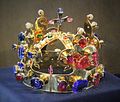 |
| Bulgaria | Heraldic Crown of Bulgaria | Heraldic royal crown with eight half-arches. Five half-arches its two-dimensional representation. Replica of original medieval crown kept in Bulgaria's National Historical Museum |  |
| Cambodia | Royal Crown of Cambodia | Lost in 1970 |  |
| Canada | Canadian Royal Crown | Heraldic crown inspired by the Tudor crown but with maple leaves replacing the crosses and the fleurs-de-lys. The insignia of the order of Canada sits on its top. |  |
| Croatia | Crown of Zvonimir | |  |
| Denmark | Crown of Christian V | Kept in Rosenborg Castle |  |
| Denmark | Crown of Christian IV | Kept in Rosenborg Castle |  |
| Egypt | Heraldic Crown of Egypt | |  |
| Finland | Crown of Finland | |  |
| France | Crown of Charlemagne | From 1271, used as a French coronation crown, destroyed in 1793 |  |
| France | Crown of tradition of the Queens | Destroyed in 1590 | |
| France | Crown of Saint Louis | Destroyed in 1793 | |
| France | Crown of the Queens of Jeanne d'Évreux | Destroyed in 1793 | |
| France | Funeral crown of Queen Anne of Austria | Destroyed in 1793 | |
| France | Gold crown of Louis XIV | Destroyed in 1793 | |
| France | Vermeil crown of Louis XIV | Destroyed in 1793 | |
| France | Funeral crown of Queen Marie Therese of Austria | Destroyed in 1793 | |
| France | Funeral crown of Henriette of France, Queen of England | Destroyed in 1793 | |
| France | Funeral crown of Philippe Duke of Orleans | Destroyed in 1793 | |
| France | Crown of the Dauphine | Destroyed in 1793 | |
| France | Gold crown of Louis XV | Destroyed in 1793 | |
| France | Crown of Louis XV | Kept in the Louvre |  |
| France | Gold crown of Louis XVI | Destroyed in 1793 | |
| France | Vermeil crown of Louis XVI | Destroyed in 1793 | |
| France | Crown of Louis XII | Destroyed | |
| France | Gold crown of Henry IV | Destroyed in 1793 | |
| France | Vermeil crown of Henry IV | Destroyed in 1793 | |
| France | Gold crown of Louis XIII | Destroyed in 1793 | |
| France | Vermeil crown of Louis XIII | Destroyed in 1793 | |
| France | Crown of Charles X | Kept in the Basilica of St Denis | |
| France | Crown of Queen Marie Thérèse of Savoy | Kept in the Basilica of St Denis | |
| France | Crown of the Dauphin Louis Antoine Duke of Angoulême | | |
| Georgia | Crown of Imereti | | |
| Georgia | Crown of Heraclius II | Lost in late 18th century. |  |
| Georgia | Crown of George XII | Missing in late 1930s. Painting kept in the Kremlin Museum |  |
| Germany | Crown of Baden | |  |
| Germany | Crown of Hanover | | |
| Germany | Royal Crown of Bavaria | Kept in the Munich Residenz |  |
| Germany | Crown of Saxony | | |
| Germany | Crown of Württemberg | Kept in the Landesmuseum Württemberg | 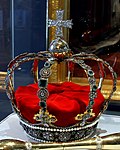 |
| Germany (Prussia) | Crown of Frederick I | Kept in Charlottenburg Palace |  |
| Germany (Prussia) | Hohenzollern Crown | Kept in Hohenzollern Castle |  |
| Greece | Crown of Greece | |  |
| Hungary | Holy Crown of Hungary | Kept in the Hungarian Parliament Building |  |
| Iran | Crown of Agha Mohammad Khan Qajar | Used by Agha Mohammad Khan Qajar. Kept at Golestan Palace. |  |
| Iran | Kiani Crown | Used between 1796–1925 by the Qajar dynasty. Kept in the Treasury of National Jewels. |  |
| Iran | Pahlavi Crown | Used between 1926–1979 by the Pahlavi dynasty. Kept in the Treasury of National Jewels. |  |
| Iran | Empress's Crown | Used by the Shahbanu of Iran, Farah Pahlavi. Kept in the Treasury of National Jewels. |  |
| Iraq | Heraldic crown of Iraq | |  |
| Italy | Iron Crown of Lombardy | Kept in the Cathedral of Monza |  |
| Italy | Crown of Italy [ it ] | Used between 1870–1946, also known as the Savoy Crown. |  |
| India | Crown of Bahadur Shah II | The crown of Bahadur Shah Zafar, the 20th emperor of the Mughal Empire. Part of the Royal Collection. |  |
| India | Imperial Crown of India | Created for George V's 1911 Delhi Durbar. Kept in the Tower of London. |  |
| Japan | Crown of Ryukyu | Lost in 1945. Replica kept in the Naha City Museum of History. |  |
| Jordan | Heraldic Crown of Jordan | |  |
| South Korea | Crowns of Silla | Kept in the Gyeongju National Museum |  |
| South Korea | Crowns of Baekje | Kept in the Gongju National Museum |  |
| South Korea | Crowns of Gaya | Kept in the Ho-am Art Museum and the National Museum of Korea |  |
| Sri Lanka | Crown of Rajasinghe II | Kept in the National Museum of Kandy, Sri Lanka | |
| Sri Lanka | Crown of Sri Vikrama Rajasinha | Kept in the Colombo National Museum, Sri Lanka | |
| Laos | Crown of Laos | Kept in the Royal Palace, Luang Prabang | |
| Libya | Heraldic crown of Libya | | |
| Luxembourg | Heraldic Crown of Luxembourg | Heraldic royal crown with eight half-arches. Five half-arches its two-dimensional representation | |
| Madagascar | Crown of Ranavalona I | | |
| Madagascar | Crown of Ranavalona III | | |
| Monaco | Heraldic Crown of Monaco | Heraldic royal crown with eight half-arches. Five half-arches its two-dimensional representation | |
| Montenegro | Crown of Montenegro | | |
| Morocco | Heraldic Crown of Morocco | | |
| Nepal | Shripech | |  |
| Netherlands | Crown of the Netherlands | Kept privately and only displayed at inaugurations in Amsterdam's Nieuwe Kerk |  |
| Norway | Crown of Norway | Kept in Nidaros Cathedral |  |
| Poland | Crown of Bolesław I the Brave | Replica made in 2001–2003 after the original was stolen in 1794 by Prussian soldiers, used to crown Polish Kings. Kept in the Wawel Castle |  |
| Poland | Homagial Crown | | |
| Poland | Hungarian Crown | | |
| Poland | Swedish Crown | | |
| Poland | Muscovy Crown | | |
| Poland | Funeral Crown | | |
| Poland | Queens Crown | | |
| Poland | Helmet crown of Casimir III the Great | | |
| Poland | Crown of Augustus II the Strong | Kept in the Dresden Armoury |  |
| Poland | Crown of Augustus III of Poland | Kept in the National Museum in Warsaw |  |
| Poland | Crown of Queen Maria Josepha | Kept in the National Museum in Warsaw |  |
| Portugal | Crown of João VI | Kept in the Ajuda National Palace |  |
| Portugal | Diadem of the Stars | Kept in the Ajuda National Palace |  |
| Romania | Steel Crown of Romania | Kept in the National Museum of Romanian History |  |
| Romania | Crown of Queen Elizabeth | Kept in the National Museum of Romanian History | 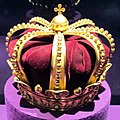 |
| Romania | Crown of Queen Maria | Kept in the National Museum of Romanian History |  |
| Russia (Moscovy) | Monomakh's Cap | Kept in the Kremlin Armoury, as part of the Diamond Fund |  |
| Serbia / Yugoslavia | Karađorđević Crown | Kept in Serbia |  |
| Serbia / Yugoslavia | Nemanjić Crown | Kept in the Imperial Treasury, Vienna | |
| Spain | Spanish Royal Crown | Kept in the Royal Palace of Madrid |  |
| Sweden | Crown of Eric XIV | Kept in Stockholm Palace |  |
| Syria | Heraldic crown of Syria | | |
| Thailand/Siam | Great Crown of Victory | Kept privately at the Grand Palace (Shown here is a replica at the Naval Museum in Samut Prakan Province) | 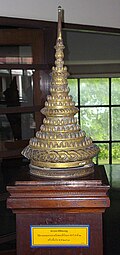 |
| Tonga | Crown of Tonga | |  |
| Ukraine | Ruthenian Crown | | |
| Ukraine | Crown of Rus | Original believed lost. Replica kept at Zolochiv Castle |  |
| Ukraine | Crown of Saint Vladimir | | |
| United Kingdom | St Edward's Crown | Kept in the Tower of London |  |
| United Kingdom | Imperial State Crown | Kept in the Tower of London |  |
| United Kingdom | Queen Victoria's Diamond Crown | Kept in the Tower of London | |
| United Kingdom | State Crown of George I | Kept in the Tower of London | 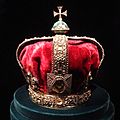 |
| United Kingdom | Coronation Crown of George IV | Kept in the Tower of London |  |
| United Kingdom | Tudor Crown | Dismantled in 1649. Replica of original crown kept at Hampton Court Palace |  |
| United Kingdom | Crown of James I | Dismantled in 1649. |  |
| United Kingdom | State Crown of Charles II | Dismantled in the reign of Queen Anne. |  |
| United Kingdom (Scotland) | Crown of Scotland | Seen here in the presence of Queen Elizabeth II at the Scottish Parliament. (Crown kept at Edinburgh Castle as part of the Honours of Scotland). |  |
| United States (Hawaii) | Crowns of Hawaii | Kept in the Iolani Palace |  |
| Vietnam | Crown of Po Klong M'hnai | Kept in the Ho Chi Minh City Museum of History |  |